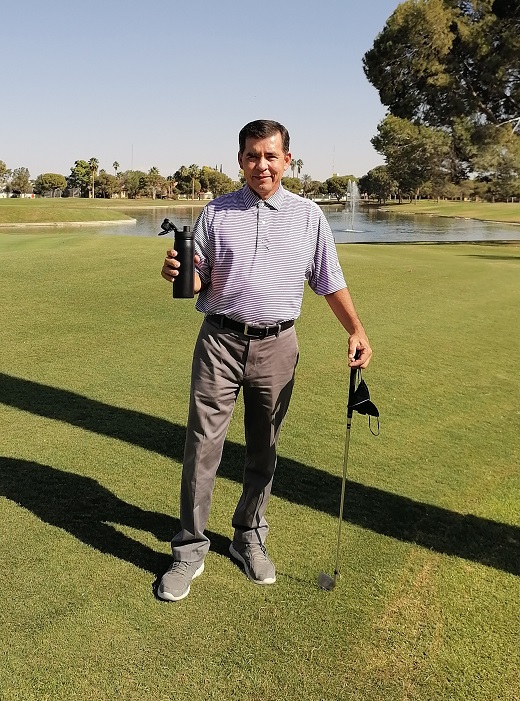
Talking in the 19th Hole
DRIVER. An effective way to plan each hole’s strategy is to do it in the opposite direction of play, that is, from the hole to the teeing area. Based on the strategic concept that indicates that the current stroke must be planned so that the next stroke is as easy as possible, the first stroke of planning is the putt. Let’s see how to plan the shots:
– The putt. The easiest putt you can have is a straight-up one. To locate it, you need to know the flag’s position and the slope of the green. With this knowledge, you determine where you want to place the ball on the green.
– The landing area on or near the green. When you have determined the place to make a straight putt and go up, calculate the landing area that allows you to reach that place.
– The place of the approach shot. When you have determined the landing area on or near the green, choose the spot on the fairway or teeing area in the case of par 3s that gives you the best angle or view to reaching that landing area. In par 5, in general, this step will be done in two approach shots.
– The place of the tee shot. When you have determined the ideal approach shot spot, determine where the tee shot will land to reach the approach shot spot. When you have already selected the landing area, decide the line and the guide that from the teeing area will give you the safest route to this area, avoiding crossing problems.
When playing tournaments on other golf courses, it is recommended that you view the hole from behind the green to the teeing area on practice day. From the green, identify the appropriate landing area for your tee shot. When you look back at the hole, it is easier to see where the different flag positions can best be reached. You can walk to feel and identify more details on your golf course in addition to seeing the hole from the green to the teeing area.
During the game round, you can take a moment in the teeing area to identify the flag’s position and think about the easiest way to reach it. Playing the hole backward in your mind before actually playing it allows you to make better decisions.
IRONS. Professionals, business people, politicians, leaders, executives, etc. who play golf do so to relieve themselves of the stress caused by their responsibilities. Most of them are organized to have a minimum of one golf day a week. Friday and Saturday are the preferred days to play with their friends, but some do it on other days and more.
Similarly, professional players of any sport are encouraged to play a complementary sport that helps them relax as an escape valve from their profession’s natural pressures. Golf is one of the complementary sports preferred by footballers, so we have a long list of players and coaches who play it. Among them: Rafael Márquez, Carlos Reynoso, Jonathan Orozco, Nicolás Castillo, Antonio Carlos Santos, Jorge Campos, Tomás Boy, Carlos Hurtado, Rubén Omar Romano, José Abella, Ricardo Peláez, Duilio Davino, Hernán Cristante, Chepo de la Torre, Isaac Terrazas, Manuel Lapuente, William Yarbrough, Milton Queiroz “Tita”, Edwin Santibáñez, José Juan Macías, Julio González, Gustavo Matosas, Luis García, Adrián Aldrete, Miguel Layún, Germán Cano, Ángel “Matute” Morales, Jared Borgetti, Moisés Muñoz, Nacho González, Fernando Navarro, Álex Aguinaga, Ramón Ramírez, Matías Britos, Luis Roberto Alves “Zague”, Gonzalo Farbán, Marcelo Bielsa, Guillermo Burdisso, Ricardo Lavolpe, Ariel Nahuelpán, Cuauhtémoc Blanco, Kikín Fonseca, José Saturnino Cardozo, Gareth Bale y David Beckham.
PUTTS. Golf clubs generate a tremendous amount of garbage; to a certain extent, it is expected that this is the case because hundreds of people attend every day, among members and employees. Still, it is ironic that on the one hand, we are in contact with nature and enjoy beautiful landscapes, and on the other hand, we pollute the planet with the use of disposables and plastic bottles. The topic of garbage is broad; today, we will focus on simple actions to eliminate/reduce the use of disposables.
– Players and employees use a thermos or sports bottle with water. It is sad to see that some members, caddies, and employees use disposable cups (styrofoam or thermal), which means that a person consumes more than 300 glasses a year; if 100 people do the same, we are talking about 30,000 glasses.
– Employees have their glass for water or a cup for coffee. Managers in each department should not provide disposable cups for employee coffee, or cones or disposable cups for water. Employees must bring their glass or mug.
– The executives should direct the efforts so that there is a change of culture in the Club regarding disposables.
– Golf Academy participants must bring their sports bottle with water. That way, they wouldn’t have to ask for water at the restaurant, 19th hole, or cafeteria. In case they have forgotten their sports bottle, have it provided to them in crystal glasses.
– The employee dining room. Employees should bring their metal silverware, or the club can provide them. Employees should be polite to eat in the dining room, avoiding take-out food as much as possible.
– The members for their education should be an example of not consuming plastic and disposables. So, they should demand that executives take action on it. Small actions make a difference.

I do not use disposables, and I avoid plastic bottles as much as possible. My student and friend Carlos Murillo know that, and he gave me a sports bottle for water. Fortunately, I have not lost it, and I use it with the satisfaction that I am contributing to a better planet. FORE.
